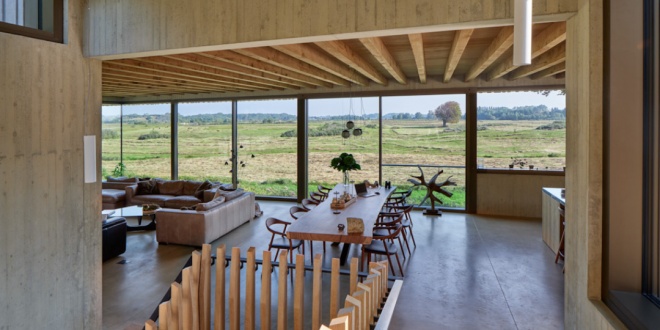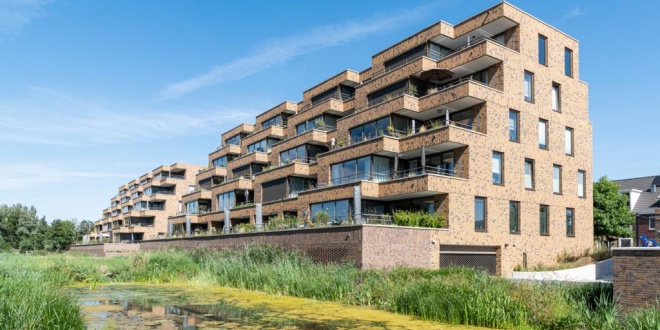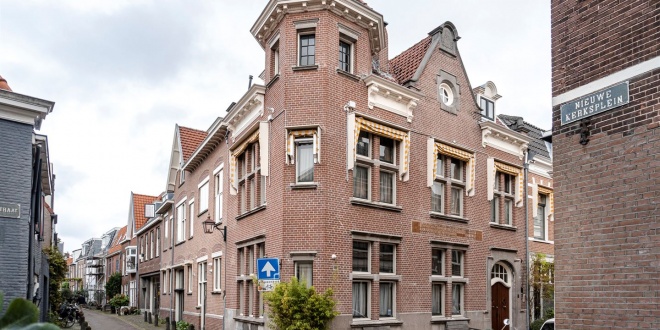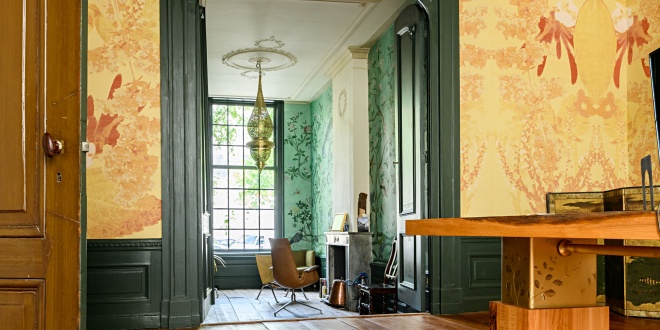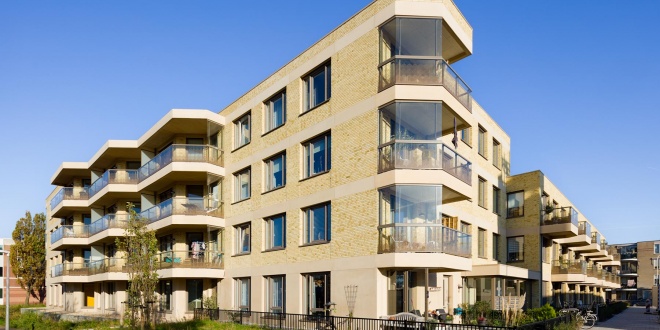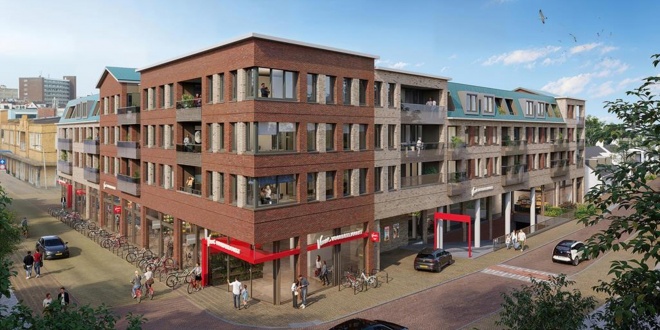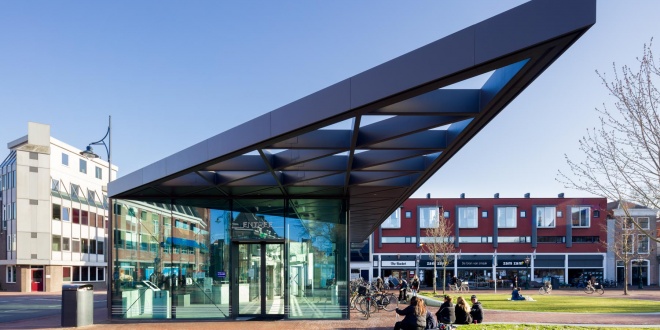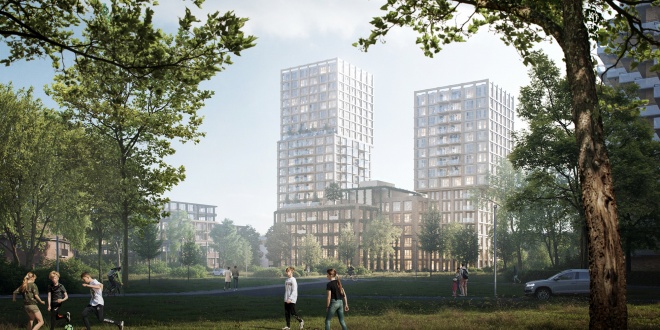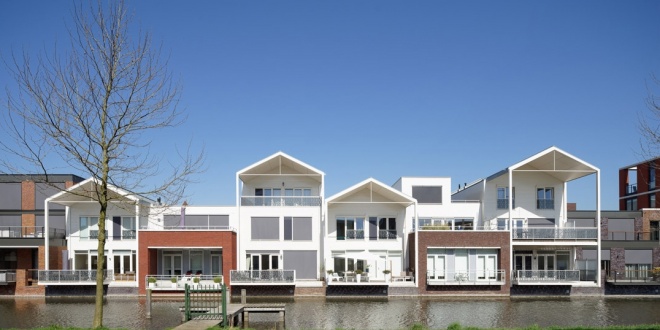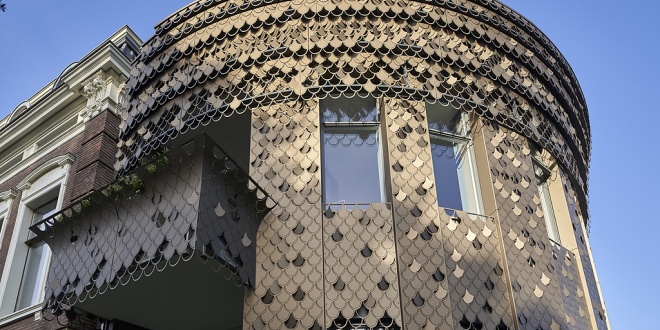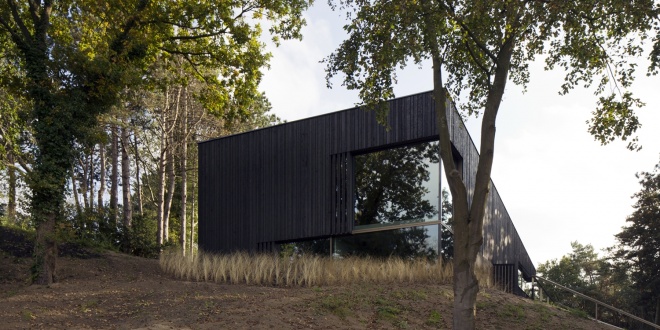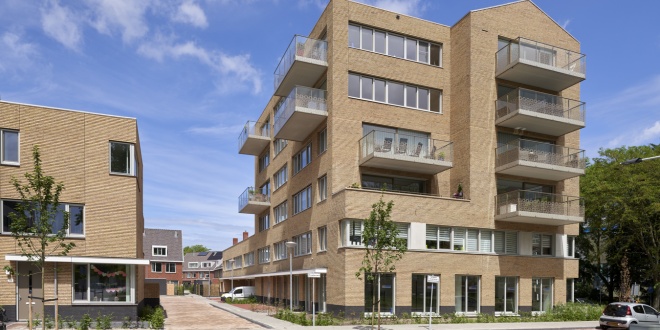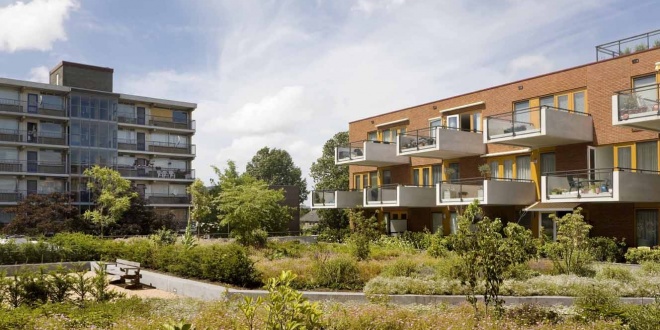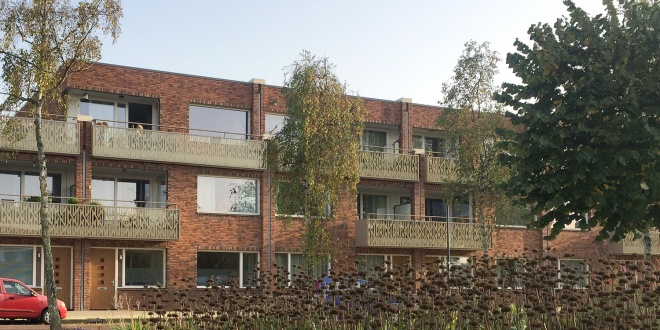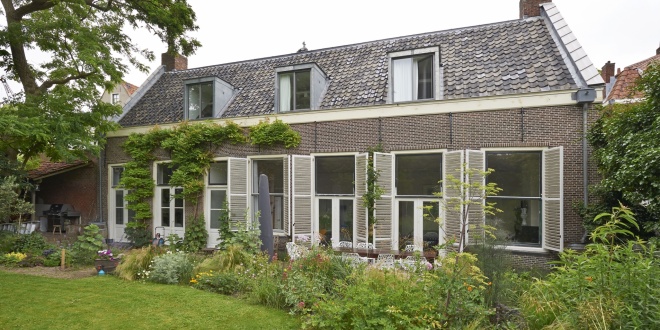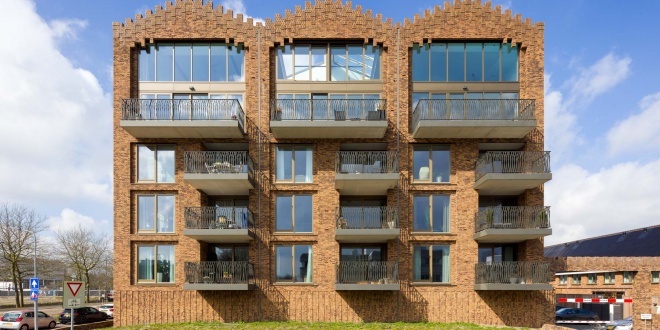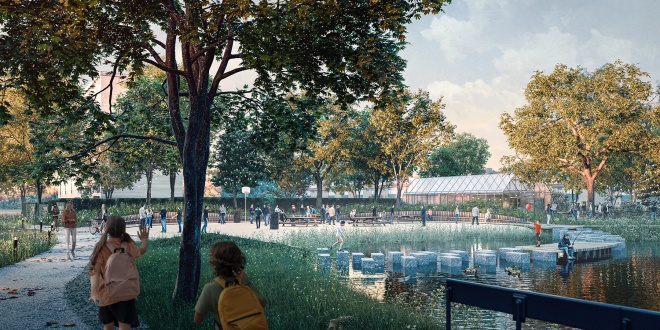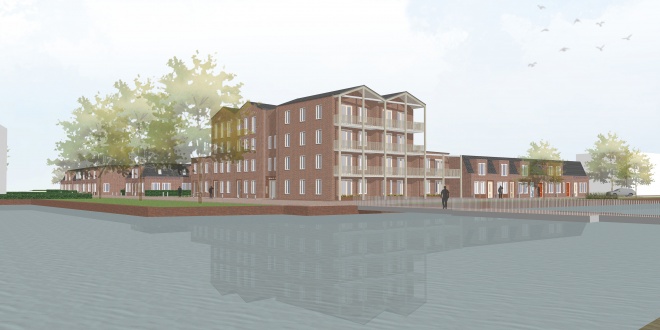The “Villa van Bergenlaan” is located in Rijksdorp, Wassenaar, on the edge of a Natura 2000 protected area.
Situated along a dune ridge, it overlooks the Lentevreugd nature reserve. The villa is modest in expression, partially embedded into the dune, allowing it to become an integral part of the landscape. Energy for the house is generated from sun and air. Because the villa is partly underground, a hybrid structure of concrete and timber has been created.
The materials — including native oak, Fraké wood, concrete, and anodized aluminium — reveal their natural character; nothing is concealed, and in some cases the materials are given a special treatment, such as the wooden slat pattern cast into the concrete. The external façade, one to two storeys high, is clad in timber with concealed window frames.
Characteristic of the villa is the experience of light, space, materiality, and connection with the surrounding landscape. The villa is composed as a sequence of distinct spatial volumes — a modern interpretation of the “Raumplan” principle.
"PURE LIVING"; the winning housing concept for the ‘Klop’ location in Alphen aan den Rijn
Together with Bemog Projectontwikkeling we have developed a vision for 3rd stage of this location in Alphen aan den Rijn. The location is the final piece of the residential area of Kerk en Zanen. It is located on the edge of the Green Heart, with beautiful sight lines on the polders. From the N11, the peripheral buildings will become the first sight of Alphen aan den Rijn.
A sustainable plan has been developed for this location (zero on the meter), which in terms of architecture fits seamlessly into the green environment. The 'Pure Living' concept consists of 40 terrace apartments, 20 water houses, 16 linked villas, a utility and neighborhood facility and a built-in parking facility. The peripheral buildings with the linked water houses and the two apartment buildings form the green boundary of the polder landscape of ‘het Groene Hart’. The greenery of the polder is visually extended into the buildings by giving each apartment its own (terrace) garden. The semi-detached villas are positioned in various ways and are adapted according to buyer's wishes.
In the heart of the Vijfhoek, a picturesque neighborhood in the historic center of Haarlem, stands a large building erected in 1908 by the Waaning company as a factory for Haarlemmer Olie. The building has since been designated a municipal monument. The section facing the Doelstraat originally served a representative function: richly ornamented office spaces were used to receive visitors and convince them of the remarkable qualities of this “miracle oil.” The rear section contained storage and staff quarters, adjoining an inner courtyard with the boiling room, where the sulphur-rich oil was produced a few days each year.
Since the 1980s, the building has been used as a residence. The division between the front and rear sections has been removed, yet the historic atmosphere remains tangible. The new owner asked us to develop a plan to prepare the entire building for a new century—energy-efficient, comfortable, and focused on the enjoyment of living, both along the street and around the inner garden. The boarded-up garage doors have been replaced with generous glazed folding doors. Using flax insulation, the building is insulated from within; new glazing is installed, and the roof is insulated from the outside. Heat pumps and solar panels provide sustainable energy generation. In close consultation with the Heritage Department, all characteristic elements are preserved—allowing the new residents to begin the next chapter in the rich history of this building.
In close collaboration with restoration contractor Burgy, EPOS Advies, and energy consultancy Kroon, a plan of approach was developed. Construction began in February 2024.
For the residential house Rapenburg 49 in Leiden, a listed national monument, we designed a plan that both enhances sustainability and strengthens the building’s historical and spatial qualities.
The house consists of a front and rear section. The period rooms in the front house have been restored to their former glory — original details and colors were reinstated, and new wall coverings were applied. The family, with two children, lives in the rear house, which they wished to renovate as sustainably as possible.
By implementing a breathable insulation system, a new insulated ground floor, and an air-source heat pump, the rear house has been successfully taken off the gas grid. During the renovation, the layout was improved, and a dormer and several roof windows were added. The connections on the ground floor between the kitchen and living/dining room, and on the upper floor between the bedroom and library, were reinstated. In all interventions, a careful balance between modern technology and historical awareness was sought.
The project was realized in close collaboration with the client, restoration company Burgy, and Erfgoed Leiden.
Photography: Arjen Veldt
The plot Oeverpolder is located in the central part of the Hoornespolder, a 1960s reconstruction area. In recent years, this district has undergone a transformation, where living is more focused on the public space and a clearer separation is made between public and private.
In the design for the new-build location, a U-shaped courtyard building was chosen, which in terms of architecture and grain size connects to the existing buildings. The green structure of the neighborhood is reinforced with the design. The transition between the residential building and the public space has been carefully designed. There are no garages, storage rooms and blind facades in the public space. The U-shaped building contains a total of 52 apartments of 53-88 m2. The building on Hoorneslaan has 4 storeys, the other two sides are 3 storeys high. The houses are all accessible via (widened) galleries in the courtyard, parking is partly in the courtyard and partly on public land, on the street.
The masonry architecture is in line with previous transformations on Hoorneslaan, but also fits in well with the existing modern reconstruction architecture of, for example, the adjacent Pniëlkerk. Due to the sloping boundary of the plot on Hoorneslaan, the building block has been given characteristic staggered façades here. It is an all-round designed building that at the same time has a new and unique character, but also fits well in the neighborhood.
VVKH, commissioned by Hoorne Vastgoed, developed the development vision for housing on top of the existing shopping center in the center of Castricum. The inward-looking shopping center, dating from the 1970s, is a single-story development with parking at ground level surrounding it. The shops are supplied from the outside, resulting in many unattractive rear entrances. There is little connection with the residential areas that have grown up around the shopping center. By adding housing to the plan, the development will reconnect with the surrounding area. Some of the housing will be positioned above the shops, and some will have front doors facing the street. These new frontages will enhance public safety, while the logistics will disappear from view. The shopping center will be clearly visible with a new entrance to Soomerwegh, the access road to the village. A new square will be added here, creating a pleasant atmosphere. By designing the entrance areas of the shopping center as new squares, the connection with the surrounding area will be strengthened. Geesterduin's stony surroundings will become greener. The plan will be nature-inclusive, providing space for flora and fauna through the addition of roof gardens, vertical greenery, and green landscaping in the squares. The entire plan will be made sustainable, with the preservation of the existing shopping center as a starting point.
Urban development and architectural integration “Vomar” location, corner of Abraham van Rooijenstraat and Maarten Kruijtstraat in Noordwijk
From an urban planning point of view, the contours and height of the building plan were determined by the municipality of Noordwijk. The plan clearly defines the streets Abraham van Rooijenstraat and Maarten Kruijtstraat, in line with the existing street profiles. Gasthuissteeg will also have a clear boundary with this building plan.
The main mass has an intermediate scale between two worlds present in the environment. On the one hand, there is the smaller-scale village development of the Hoofdstraat and on the other hand, the large-scale hotel development. The mass of the new building block to be built is 3 storeys high plus a roof storey. It is articulated into a number of volumes, softening the scale of the building block. These volumes are made independent by different colors of masonry and roof finishes. With a play of rhythm between balconies, windows, tires, roof moldings and a green-copper-colored roof, the building blends in well with the seaside resort architecture of the environment. The mass on the Gasthuissteeg is 2 storeys high. It has a green facade with window openings. On the north side of the plan, the existing firebreak will be closed and the buildings will close directly on the adjacent plot.
The plan is mainly sustainable because of the triple land use. The building block has an underground floor, on top of that a storey layer, above that a parking deck for the houses and 42 houses.
Abraham van Rooijenstraat is an important access road. That is why functions such as the entrance to the underground parking garage, the entrance to the parking deck on the 1st floor in front of the houses, and the entrance to the expedition have been made here. The Kruisstraat will become more traffic-calmed. This will be the world of shopping as it is at the Hoofdstraat. This is where the shopping functions will be located, which are accessed via two clear entrances at the corners. These entrances are clearly visible from the Hoofdstraat and from the Grent.
The entrance to the houses is on the north side. This will give the existing loading and unloading yard, where other residential accesses are located, a quality impulse. The gallery facade, which is hardly visible from the public space, is conceived as a veranda world. It's a light world of painted wood.
The team with VVKH Architects, Dura Vermeer and Besix has been selected for the design and build of a five-story underground parkinggarage in the historical center of Leiden.
In close consultation with the municipality of Leiden, VVKH has developed an urban development plan for the redevelopment of two office buildings on Verbeekstraat in Leiden. What is currently a densely populated area dominated by cars will soon become a vibrant, green, and people-friendly residential area. In line with the municipality's high-rise vision, several buildings will be added along Plesmanlaan, creating a new cityscape along this access road to the city. Together with the developments at the Bio Science Campus on the opposite side of the road, this will create a new and innovative urban district.
The plan ‘de Biezenhof’ is part of the new residential area ‘Waterrijk Woerden’ and is situated along a natural watery region. The urban scheme of ‘Waterrijk Woerden’ was designed by West 8 and refers to the traditional Dutch water cities such as Delft and Leiden. The design is made in collabiation with Klunder architects. Almost every dwelling is individual and has a specific connection to the water.
The plan of Biezenhof is divided in two parts: there is one block of family houses around a courtyard on the edge of the lake, and there is a row of water houses and apartments along a canal.
The buyers of the houses could choose between several types of houses as well as between four architects. Due to the possibilities in combining type and architect, not one house is the same. Every house has a singular character: the lake houses have a beautiful view on the lake, the street houses have a garden, and the canal houses enclose big terraces. In the public space there are a few parking places, the majority of parking places are organised in garages.
The houses designed by Knappers are characteristic because of the huge roof overhanging the façade. This contributes to the shelter-against-the water identity of the houses, and refers to the greenhouse glass constructions in the low lands. At the street side these houses are made of brick, which gives them a closed and open (to the light and the water) individuality.
The Plantsoen in Leiden is well known for the historical appearance of both the city park (1836) and the houses of the last quarter of the 19th century. The park was originally landscaped on the edge of the city in the place of an old defense belt. At the entrance of the park at the east side the monumental building Plantsoen 1 – 3 is redeveloped in a complex with 6 apartments. The apartments of about 150 m² are provided with all luxury and comfort, such as a private indoor garage, spacious roof terraces and an elevator, while retaining the historical look and value of the building. Redevelopment also applies to sustainability; obtaining Energy label A. Exterior facades, window frames and roof are additionally insulated. The houses are underfloor heated and solar panels are provided on the roof.
The municipal monument at Plantsoen 1 – 3 is divided over three floors and a basement. The property at number 1 was originally a fully detached house, number 3 was part of a block of 3 houses. Both buildings date from 1875 and were connected in 1957 and converted into one large nursing home. In this function change, the original qualities have largely been lost. The round expansion at number 1 dates from 1993.
In the new layout with 6 apartment, the monuments are restored to their former glory by restoration contractor Burgy from Leiden. The façade of the intermediate building is renewed and aligned with the monuments. The existing façade of the round building is finished with a bronze wall cladding, a ‘veil‘ with a leaf motif. This pattern is inspired by the leaf motifs and decorations of the 19th century, which can still be found in various places along the Plantsoen. The round with ‘veil’ becomes a special recognition point in the inner city.
Each apartment has both rooms in the monumental area as well as in the newer parts. The interior of the monumental buildings is provided with appropriate details to bring back the historical character as much as possible. This specific part is provided by Verlaan & Bouwstra architects from Vianen.
On the inside buyers have a lot of freedom of choice; they can choose for an even richer historical finish with wall tension, panelling and en-suite layout or a tight, modern finish and layout; both are possible. Each apartment is unique, has its own layout and its own character. Only the view is the same for all apartments; they all look out over the beautiful monumental city park the Plantsoen at the town canal.
The redevelopment was completed in July 2018.
Villa Meijendel takes its name from the nature reserve in which it is located, where a forest meets a valley of dunes. The house is constructed from concrete and set into the side of a sandy slope. The building's design aims to create a dialogue with its surroundings, both through the way the form and materials engage with the landscape, and through the use of glass to provide views out from and into the house.
The boxy geometric structure is entirely clad in charred timber, creating a textured black surface that appears different depending on how sunlight falls on it. The exterior finish, inspired by the ancient Japanese shou sugi ban technique, also helps to preserve the wood. Sometimes the house is almost invisible against the dark edge of the forest, sometimes it sparkles in the sunlight because of the glittering charred wood, as such forming a background for the play of shadows of tree trunks and branches. The villa hides and reveals itself in the landscape.
The property has its entrance on a middle level accommodating an office and two bedrooms. Stairs ascend to an open-plan kitchen and living space, and drop down to a master bedroom and gym room.
The living room features a full-height corner window that looks out through the trees towards the dune valley. A lower window facing to the rear and a large glazed surface lining the adjacent double-height circulation area face out onto the forest. At the far end of the first floor, sliding glass doors lead out from the kitchen onto a terrace.
The material palette –concrete, steel and anodised aluminium– was chosen to complement the tones and textures of the surrounding environment. Each material is applied in a raw, untreated form. Internally, the walls are finished with smooth concrete, while the rough-sawn Douglas fir beams supporting the ceilings feature a distinctive grain.
West 8, Adriaan Geuze, is responsible for the garden design.
Photography is by Christian van der Kooy
In cooperation with Smits bouwbedrijf, VVKH has won the european tender to develop a new housingarea in district Dieperhout in Leiden. The project consists of 48 dwellings, 12 apartments and a care facility of 1500m². Start of the constructionwork is planned in may 2015, because thats when a current school will move to a new building and the site will be available.
The “Meerwijk” district in Schalkwijk, built in the 1960s, has been built on the corner of Bernadottelaan and Albert Schweizerlaan. This center is part of the urban design that was made by our office in 2001. The building with retail spaces, including the Vomar supermarket, an underground parking garage with 215 places and 74 apartments, is one of the sub-plans of the community center. The whole has a modern, transparent and friendly character and adapts well to the neighborhood.
Together with restoration contractor Burgy from Leiden, the back house, the garden house of the house at Garenmarkt 9 / 9a, has been completely restored and modernized. The new owner lives in this part. The front house with a number of apartments / studios for rent will remain unchanged for the time being.
The house at Garenmarkt 9, 9a is also popularly known as 'Thorbeckehuis'. The house has one of the largest private backyards in Leiden. In the Secret Annex, the garden house (No. 9a), the liberal statesman Johan Rudolph Thorbecke wrote in 1848 the revision of the Constitution, which turned our country into a constitutional monarchy. Thorbecke has lead three cabinets from 1849. A gable stone in the national monument reminds of the habitation by the liberal statesman and professor of law (1798-1872).
At the beginning of the Kruisweg, the housing project ‘Gemaalhuis’ marks the entrance to Hoofddorp. In collaboration with Timpaan, RROG Urban Planning and Landscape and IBB, moes have been realized in a place where offices used to dominate in the past.
The design for 83 dwellings near the center of Hoofddorp provides a transition between the village ribbon development along the Kruisweg and the large, urban scale that Hoofddorp aspires to. At the design site, the original polder structure was situated perpendicular to the direction of the rest of the Haarlemmermeer. In the design, a passage has been made here in the building block: a quiet residential court without cars and shared use of public space. The buildings are all-sided, refers to the past and seems to have been there for some time without being historicizing. The architecture is robust and stony. Rich brick details refer to the steam pumping stations that stood at the beginning of the creation of Hoofddorp. The complex is a neighbourhood in itself and has variety of housing typologies; single-family houses, veranda houses, terrace houses and apartments. The apartments are designed as freely divisible lofts.
The homes were completed in June 2020.
In the summer of 2024, the municipality of Leiden launched an ideas competition for the Second Green Ring. Following the success of the Singelpark around the historic city center, the idea emerged to connect the parks and waterways along the city’s edge into one continuous whole — a green-blue ring where residents of the densely built city can recreate, exercise, experience nature, and meet one another.
Studio VVKH, together with partners in the fields of landscape architecture, water management, ecology, and industrial design, submitted a vision titled ‘Het Leidse Lint’ (“The Leiden Ribbon”). With this vision, we were among the three finalists invited to present their plans to a broad jury in March of this year. The citizens of Leiden were also able to view the proposals and share their opinions.
Our submission achieved second place. The winning proposal was ‘Panoramapark’ by Polyfern. We are proud of this result and greatly enjoyed developing our ideas for the city. The importance of outdoor space — for people, plants, and animals alike — will increasingly come to the forefront of design at all scales in the years ahead.
You can download the presentation boards of ‘Het Leidse Lint’ here.
The design team consisted of:
VVKH, Jan Maurits van Linge (landscape office Xi-ontwerp), Simon Akaya (npk design), Yasmin Stip (Stip werkt), Harma van der Meer (TU Delft), and *Ada Jaśkowiec.
Middelsee is the expansion plan on the southwest side of Leeuwarden, based on an urban design by West 8. The Frisian water city serves as a source of inspiration. Commissioned by the smallest housing association in the Netherlands, we have designed a plan for homes arranged around two green courtyards. It forms a small-scale community with plenty of space for encounters, and a robust waterfront with the apartment building as its eye-catcher.
Using simple means, variety is created so that no more than two houses are ever the same. The foundation remains consistent: a compact floor plan, lightly jointed red brickwork, and solid white window frames. We introduce variation through a dormer or a brick roof extension, a roof edge detail, or a distinctive entrance feature. The client’s existing housing stock in Leeuwarden’s city center also served as inspiration — a characteristic working-class neighborhood with abundant greenery.
In our plan, residents meet each other around private stoops and gardens bordered by low hedges, as well as along the wide galleries on the timber façade of the apartment building. Shared bicycle storage areas and shared cars also contribute to the sense of community.





